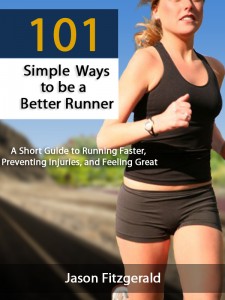As I look back on over 15 years of running, it’s painfully obvious that I’ve made every mistake possible.

Did I hurt my IT band… and then jump back into a fast workout two days later? Ugh, yes.
Did I increase my mileage by 10%… every week for two months until I injured my knee? Sadly, yes.
Did I skip all of my strength workouts because I thought that running was enough? I’m not proud to admit it, but yes.
My training used to be haphazard and cobbled together from a patchwork of different sources online. I’d hop from one running philosophy to another thinking I just needed the “right workouts.”
I was so wrong.
And my running paid the consequences: For years my personal bests plateaued, even though I was running hard workouts. I suffered through almost every injury imaginable: plantar fasciitis, achilles tendinopathy, IT band syndrome, and more.
It wasn’t a fun time to be a runner and I was frustrated. I was stuck in the injury cycle.
But even though I was rebellious, I gradually started listening to my coaches (I’ve had more than ten and wouldn’t be where I am today without all of their guidance). I worked smarter, not harder.
It paid off: my senior year in college I set personal bests in 8k cross country, 5k, 3k, the mile, and 800m. I also debuted at the steeplechase, qualifying for the New England Championship meet and finishing in the top 10.
None of that would have happened without the guidance of older runners who knew better and some very smart coaches.
Just think: where would you be today if you could learn from someone who’s made all the mistakes but learned from them? Even if you avoided just one mistake or made one upgrade to your training, how much could that benefit you?
Those small, short lessons can have powerful effects as they ripple through your running for months and even years to come.
So today, I want to share five lessons I’ve had to learn the hard way. I hope you can use them to become a smarter runner than I was!
These are excerpts from my book, 101 Simple Ways to be a Better Runner: A Short Guide to Running Faster, Preventing Injuries, and Feeling Great.
It’s available on Amazon for the Kindle or as an instant PDF download.
Be a “Core Whore”
My wife jokes that I’m a core whore because I make a 15-20 minute core session an almost daily part of my post-run routine. You don’t necessarily need to do a core workout every day, but start doing one about 3 times per week and you’ll start seeing real results.
Focus on whole body exercises that you can do anywhere, like pushups, planks, bridges, and lunges. An effective general strength routine that I used frequently is the Standard Core Routine.
A more strength oriented workout is the ITB Rehab Routine. The ITB Rehab Routine is focused on glute and hip strength – two areas that are particularly weak among most distance runners – and is great for overall injury prevention, not just for those who suffer from Illiotibial Band Syndrome.
Increase your cadence to 180 steps per minute
Now, there’s nothing inherently “magic” about 180 steps per minute. There’s no ideal stride rate. But an approximate stride rate of 180 will help alleviate many inefficiencies in your running form.
A quicker cadence will help reduce impact forces and your chance of injury. It will also dramatically lower the chance that you’re over-striding.
There are a lot of running form articles that will recommend you focus on being a midfoot striker. Sure, this is important (and I recommend it as well), but the best thing you can do to improve your form is by taking quicker steps. Aim for at least 170 but ideally you’ll be somewhere around 180 steps per minute.
Consistency, consistency, consistency!
Running well takes months and years of diligent work. Unfortunately, there’s no short-term fix or “get fast quick” plan out there. Distance running is a long-term sport and it takes the top athletes years – sometimes decades – to reach their genetic potential.
Remember that what you run today impacts what you’re able to do next week, which impacts what you can do next month, etc. Consistency is king and you’ll often get better results by adding a little bit of running for a few months than trying to jump up your mileage over just a few weeks. Small changes, made over a long period of time, will ultimately help you be a better runner.
[Further reading: How to Make Running a Habit that Sticks]
“Run the first third of a race with your head, the middle with your personality, and the last third with your heart”
This quote by Mike Fanelli encapsulates the simplest, best way to run a race. It’s helpful to start a race logically at your goal pace. Don’t go out way too fast – think it through.
The middle third of a race can be run with your personality – this means whatever is most comfortable for you. That could include:
- Staying on your goal pace.
- Running faster than goal pace.
- Sticking with a group of runners near you.
Then when you reach the final third of the race, you run with your heart! Pour your soul into the race and see what your body is capable of doing. You might just surprise yourself.
Run harder on your hard days and easier on your easier days
Most runners run a “medium” effort on most days. They go out for their run and run “their pace” for the entire duration of the workout. This strategy doesn’t take advantage of the adaptation cycle; there’s a better way!
Make your easy days easier by running less and running slower on those particular days. But an easy day is best if you also take care of yourself by using your foam roller, taking an ice bath, and getting extra sleep. And when it’s time to run hard, make sure you don’t slack off! Your body needs to be pushed to get faster.
Get Smart with Your Running
You don’t need ten coaches or a library of running books to plan a good season of training or races. 
Sometimes, you just need a few small tweaks to what you’re already doing to finally allow yourself to accomplish what you’ve always dreamed.
If you want to read even more “small tweaks” (102 of them to be precise), you can get the full list in my Kindle book 101 Simple Ways to be a Better Runner on Amazon now.
No Kindle? No problem! Download the book as an instant PDF here.
Now let me ask you: What lesson took you years to learn but later dramatically helped your running?